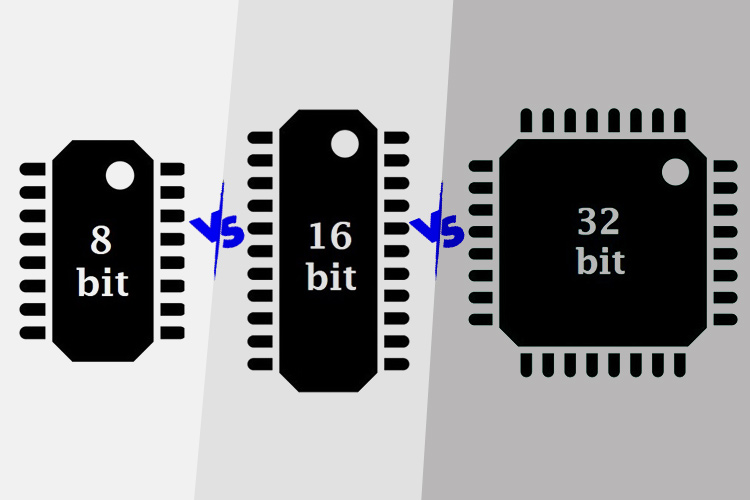Optimized at frequencies beyond traditional industry targets to support emerging applications
Why 32-bit MCUs are not always the superior choice? Comparing 8-bit, 16-bit, and 32-bit Microcontrollers

A typical electronic circuit design consists of passive devices like resistors, capacitors, inductors, and active devices like Integrated Circuit (ICs), Diode, Transistors, etc. But among them, the most important component which acts as the brain of your design is a microcontroller or processor. Now, there are many types of microcontrollers in the market, and selecting the right microcontroller for your application is often important. In this article, we will focus on the different bit sizes available in a microcontroller and we discuss the difference between 8-bit, 16-bit, and 32-bit microcontrollers and how to select the right one for your project to obtain an optimal price to performance ratio. So, without further ado, let’s get right into it.
What is bit-size in a Microcontroller?
Now as we all know, a microcontroller is a special kind of IC, which is a single integrated circuit with a CPU, memory, and programmable I/O peripherals. We can program any microcontroller to do different tasks depending on our purposes. But there are a lot of different devices to choose from, so we divided this chip or ICs into various categories based on the speed of operation, bits size (8-bit, 16-bit & 32-bit), memory (External Memory Microcontroller, Internal/Embedded Memory microcontroller), and Architecture (RISC, CISC).
Trade-off in choosing between 8-bit, 16-bit, and 32-bit Microcontrollers
After understanding what a microcontroller is, now you need to choose the device as per the requirements of your applications. Let us now try to understand what kind of features of microcontrollers we need to see. The 8-bit, 16-bit and 32-bit microcontrollers are not very different in terms of cost but they can be deferred based upon their power usage, execution time, peripheral counts, I/O counts, etc.

Basic Differences between 8-bit, 16-bit, and 32-bit Microcontrollers
Nowadays, when we talk about microcontrollers, the first thing that comes to mind is the term 8-bit microcontroller. It processes with 8-bits of the data bus, which means this microcontroller can move 8-bits of data in a particular time frame. Then there is a 16-bit microcontroller and as the name implies, theoretically, it is two times faster than an 8-bits controller, and finally, there are the 32-bit microcontrollers. The 32-bits microcontrollers can move more data in a particular time frame as compared to 8-bit and 16-bit, as 32K is larger than both 8 and 16. For that reason, a 32-bit microcontroller can handle the quadruple amount of data as compared to the 8-bit and 16-bit processors which make the 32-bit microcontroller more data-efficient. But it makes the processor more power-hungry.
Arithmetic Operation:
As per arithmetic operations, these microcontrollers are different from each other. Each type of microcontroller has its own range of data set. For an 8-bit microcontroller, it can handle only 0 to 255 bits and 16-bit can handle 0 to 65,535 and a 32-bit microcontroller can handle up to 0 to 4,29,49,67,295. When data width becomes large, the microcontroller’s arithmetic core allows the controller to compute a large amount of data in an instant.
Clock Speed:
When we talk about the difference between microcontrollers, the data processing speed is a big factor to consider. In a microcontroller, data is processed in a particular time frame and the time it takes to process this data is dependent upon the Crystal Oscillator and depending upon the microcontroller type it can be an internal or external clock. 1Mhz crystal is equal to 1000000 cycles/second. So, 1 cycle is an execution of 1 instruction or data processing. The 8-bit and 16-bit microcontrollers are supported up to 40-64Mhz of the crystal, where a 32-bit microcontroller can support >100Mhz crystal. Which makes the 32-bit microcontroller a more time-efficient microcontroller. But there is also a drawback, that is more clock speed is equal to more power consumption.
Memory:
Like clock speed, a 32-bit microcontroller also comes at the top of the list. Because in general, the memory capacity of a 32-bit microcontroller has eight times more memory than the 8-bit and 4 times more than a 16-bit microcontroller.
Form Factor:
According to the hardware’s structural form of a microcontroller, it is not true that the 32-bit microcontroller always comes in a larger package form (like TQFP, QFP, VTLA, TFBGA). Some 8-bit or 16-bit microcontrollers also come into the same form with the same number of pins (In that case some pins are not connected to the microcontroller).
Peripherals:
If we compare the 8-bit and 16-bit microcontrollers to a 32-bit microcontroller, we can clearly observe the difference. In a certain scenario if there is a need of Ethernet, CAN, USB, Modbus, and more, we have to choose a 32-bit microcontroller, because it comes bundled with these features, and in general, they also have necessary software support because 8-bit or 16-bit microcontrollers are insufficient for that reason we need to add peripheral ICs to resolve those issues but its effect on the cost.
To conclude, we can say after discussing the pros and cons of the different microcontrollers, now is your decision to choose the right microcontroller for your project. While designing and developing an application, always be careful with the time and overall cost. By considering the data process speed, memory, usage of the peripherals, and complexity of PCB design, you will minimize your decision to choose the correct microcontroller for your project.








